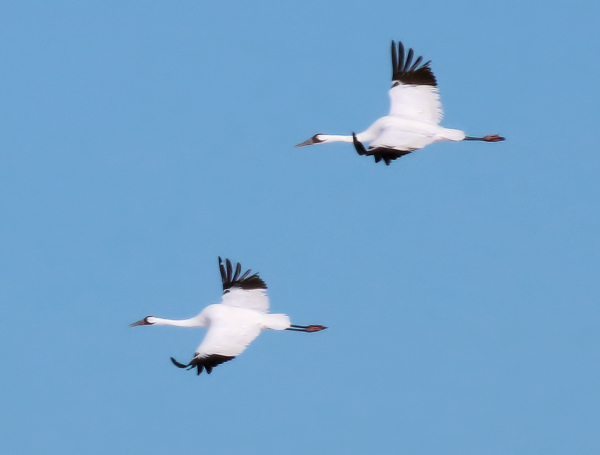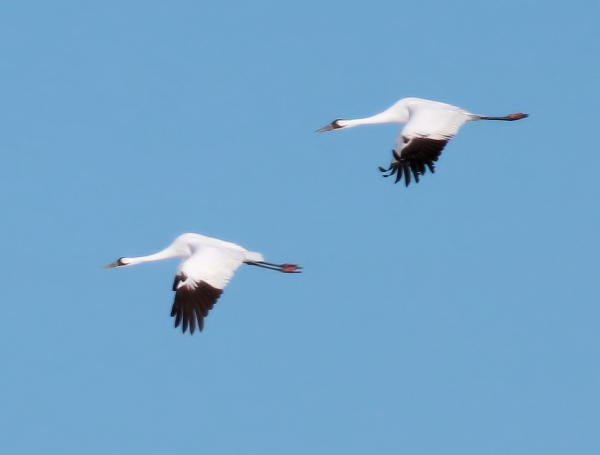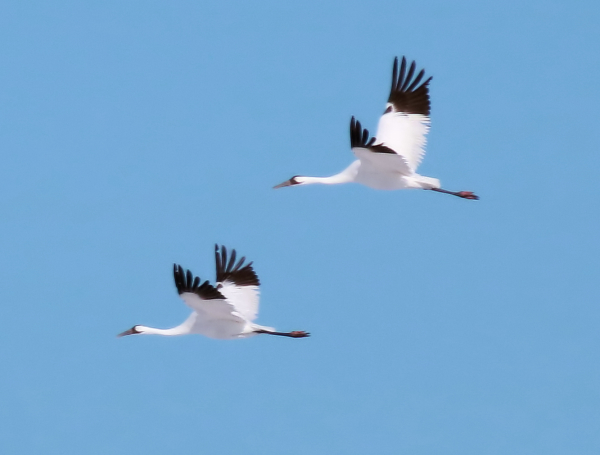   The pair of Whooping Cranes in flight provided memorable photos that show the beauty and majesty of these rare birds. |
As I slowly approached the Whooping Crane hangout, there they were, two Whoopers in flight! I pressed forward to try to get to a better position in relation to the sun to take some documentary photos in the clear afternoon sky. I didn’t get far before the grand white cranes turned north – perfect. I photographed their broad wingbeats, slow and stylized as they caught the full sun as they passed by and even angled closer to my position. I was excited to say the least, but simultaneously in awe of these majestic birds, the tallest birds in North America with one of the largest wingspans, not to mention their rarity, especially during their migrations across the Great Plains.
It’s hard to explain the level of emotion I feel around Whooping Cranes – and I’m not alone. They have an energy, an aura, an ethereal quality that rivals spirituality. And now, watching them in graceful flight they emitted a feeling of peace too. Other standout birds during that Wednesday afternoon visit to Sand Lake Refuge included 3 different Rough-legged Hawks, a group of 8 Tundra Swans and a separate pair, plus an unusual sighting of a roadside Black-bellied Plover that I only noticed when it flushed as I drove by – like one of the more common Western Meadowlarks in the area.
Floodplain Friday
Friday afternoon I had Whooping Cranes in sight again – 2 small white dots in the distance – but they were scheduled to take flight any moment and I was hoping they might pass near enough to my position for me to photograph as they reposition to the harvested corn field where the pair has been feeding for a week (the Whoopers were first reported October 19th). This was the first time I’ve located the pair in the broad floodplain of the trickling James River, the primary source of water for Sand Lake National Wildlife Refuge. The Whoopers were actively feeding in the afternoon sunlight, although I could only speculate what they were finding as the high temperature hovered just above freezing.
As I waited on the edge of the marsh, I settled into the quiet scene that periodically was broken by a small flock of Mallards, Cackling Geese, or Canadas. A female Northern Harrier glided above the cattails on a south breeze, a cock pheasant crowed nearby, and 20 minutes later 4 hen pheasants warily crossed an opening in the tall grass. Suddenly, the quiet was broken by a familiar fall sound – Sandhill Cranes – as a small flock of 6 Sandhills took flight over the marsh and landed in the area 100 yards south of the Whoopers, followed by 5, 3, 4, and 3 more Sandhills (21 total). Sandhill Cranes were new to the area, and a welcome addition, as were 2 Tundra Swans that flew low following the shallow rivercourse before landing out of sight behind cattails.
That’s when the Whooping Crane family took flight, revealing themselves for the first time at 3:50, about 40 minutes after I arrived. They positioned themselves where I initially observed the pair of Whoopers, that made their way somewhere behind a stand of cattails. The marsh settled down for a while until a second-year Bald Eagle flew low on a recon flight, flushing up a couple hundred Mallards and 8 Sandhills that circled back as the eagle passed. At 4:30 the pair of Whoopers flew up from behind the cattails and landed next to the flock of Sandhills, with the slightly larger male Whooper holding its wings spread at its sides as a few Sandhills took a few running steps to each side. Advancing aggressively, the Whoopers displaced the Sandhills and began feeding again.
I could see all 5 Whooping Cranes, plus Sandhill Cranes, until 4:45 when the family group took flight to their preferred feeding location northeast of my position, almost 2 hours later than “normal.” I waited another hour as flock after flock of 100 Mallards flew out of the floodplain, headed west to feed. I had been holding out for another photo opportunity with the Whooper pair, but I was more than satisfied to share a tranquil afternoon with the birds of lower Sand Lake, including both species of North American cranes – a rare time to be savored.
Snow Goose Sunday
After another clipper wind storm Saturday, the following morning was surprisingly calm and as I started a 15-mile transect drive south and north of home. I was thrilled to see about 300 Snow Geese landing in Melody’s Marsh, less than a mile south of home. Two miles north, 2 larger flocks of Snow Geese were concentrated on 2 big lakes, numbering maybe 1,000 and 2,000 each. Then 7 miles north there were a few thousand more Snow Geese on the edge of the deepest lake in the area.
Seven miles to the south, a couple hundred Canada and Cackling Geese lined the shore of a big lake that had about 100 Buffleheads, 200 Lesser Scaup, and a few Canvasbacks spread across the perimeter shallows. And to round out the waterfowl along my transect, about 40 Canada Geese swam near the road 2 miles south of home. There was much less ice on the lakes, and with high temperatures returning to the 60s this week, many smaller wetlands will return to ice-free status.
This week, birds of prey have been nearly absent in the area, except last Tuesday I sighted 2 Bald Eagles perched on the edge of the deepest lake, and another about 5 miles south of my office. Hawks have indeed been absent during my area observations last week, although during my 70 mile drives to Sand Lake Refuge I observed scattered Rough-legged Hawks and Red-tailed Hawks, along with a few Bald Eagles around the refuge.
Goose Music Monday
As I went to bed Sunday night, and as I awoke Monday morn, goose music filled my ears – evidence of a very special time of the year. Although I was impressed with the big flocks of geese Sunday, Monday showed an even bigger influx of Snow Geese, including tens of thousands on the deep lake 7 miles north. My best guestimate was more than 20,000 Snows and Ross’s Geese! They seemed very tired as I focused my binoculars on geese along the perimeter of the huge concentration – most were resting their head on their back as they floated on the glassy water. I wondered where they came from overnight, but was more excited they were here now.
There were also about 300 Snow Geese on the edge of a wetland just ¾ mile northwest of home; but the nice thing about that congregation was that it included 5 species of geese – with a couple small flocks of outlying White-fronted Geese, small mixed flocks of Canada and Cackling Geese, and plenty of Ross’s Geese mixed in among the dominant Snow Geese. I also found another 1,000 or so Snows on a marsh about 5 miles to the south.
That afternoon, I opted to do some work in my front yard rather than to monitor the feeding flights. But during the 2-hour period I worked outside, geese flew low overhead constantly – in essence the geese came to me – although they were actually headed to feed in an ever-growing flock less than a mile south of home. After sunset I saw the big flock fly up and reposition a couple times and imagined it must number half-a-thousand, at least. After finishing my project at last light, I drove south to get a better view, and could barely make out the geese feeding right next to the road, with hundreds already on their night roost in the middle of Melody’s Marsh, ensuring goose music again Monday night. Gotta love it.
Backyard Ins and Outs
Last week I added a platform feeder to my feeding station, partly to facilitate easier access to nuts and seeds for Blue Jays, and I add some loose thistle seeds too, making the new feeder more attractive to goldfinches, siskins, and even Harris’s Sparrows, which surprised me to see them utilizing the feeder 3 feet above ground. The Blue Jays tend to fill their gullet with pieces of nuts that they carry to another location to cache; hopefully that will keep them in the area over winter.
Sunday’s feeder birds showed an overnight change again with the addition of a couple American Goldfinches, along with more nuthatches, both White-breasted and Red-breasted. Conversely, no Harris’s Sparrows appeared, nor Pine Siskins, and only one adult White-throated Sparrow stopped by for a moment later in the afternoon. Just as new birds arrive, others leave – such is the pulse of the season. Enjoy your week!
Article and photos by Paul Konrad
Share your bird sightings and photos at editorstbw2@gmail.com
